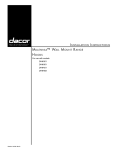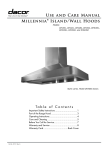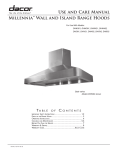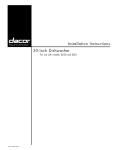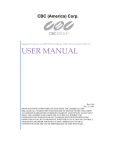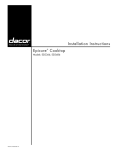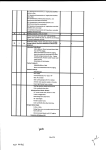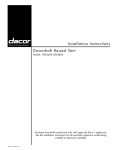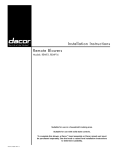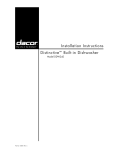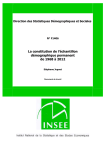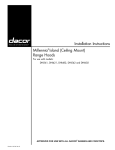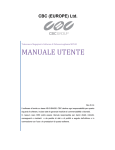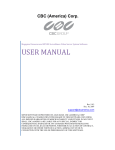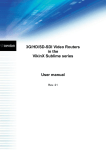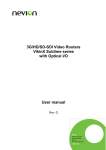Download Dacor DHW421 Specifications
Transcript
Installation Instructions
Millennia®Wall Mount Range Hoods
Models: DHW301,
APPROVED
Part No. 101743
Rev. F
DHW361,
DHW421
and DHW482
FOR USE WITH ALL DACOR ® RANGES
AND COOKTOPS.
Important Safety Instructions ..................................... 1
Important Information About Safety Instructions ......... 1
General Safety Precautions ........................................ 2
Installation Specifications
.......................................... 3
Performance Specifications ........................................ 3
Electrical Specifications .............................................. 3
Dimensions .................................................................
3
Planning the Location ................................................. 3
Planning and Installing the Duct Work ........................ 4
Installation Instructions ............................................... 5
Installing the Mounting Bracket ................................... 5
Verify the Package Contents ....................................... 5
Installing Chimney Mounting Bracket .......................... 6
Hanging the Range Hood ........................................... 7
Connecting the Duct Work .......................................... 8
Final Electrical Installation .......................................... 8
Final Chimney Assembly ............................................. 8
Verifying Proper Operation .......................................... 9
Installation Checklist ................................................... 9
Wiring Diagrams .........................................................
10
Notes ............................................................................
12
Important:
•
Installer: In the interest of safety and to minimize problems, read these installation instructions completely and
carefully before you begin the installation process. Leave these installation instructions with the customer.
•
Customer: Keep these installation instructions for future reference and the local electrical inspector's use.
If You Need Help...
If you have questions or problems with installation, contact your Dacor dealer or
the Dacor Customer Service Team. For repairs to Dacor appliances under warranty call the Dacor Distinctive Service line. Whenever you call, have the model
and serial number of the appliance ready. The model and serial number are
printed on the appliance data label (see below for location). Remove the filter(s)
to view the label.
Dacor Customer Service Team
Phone: (800) 793-0093 (U.S.A. and Canada)
Monday -- Friday 6:00 A.M.to 5:00 P.M.Pacific Time
Web site:
www.Dacor.com
Dacor Distinctive Service (for repairs under warranty
only)
Phone: (877) 337-3226
Monday -- Friday 6:00 A.M.to 4:00 P.M.Pacific Time
Appliance
All specifications
Data Label
•
The appliance data label contains the model and serial number information
and the electrical requirements.
•
The label is located inside the hood chassis behind the filter(s). Remove the
filter(s) to view it.
subject to change without notice. Dacor assumes no liability for changes to specifications.
© 2008 Dacor, all rights reserved.
Important Information About
Safety Instructions
Safety Symbols and Labels
[_ DANGER
The Important Safety Instructions
and warnings in
these instructions are not meant to cover all possible
problems and conditions that can occur. Use common
sense and caution when installing, maintaining or
operating this or any other appliance.
•
Always contact the Dacor Customer Service Team
about problems and conditions that you don't understand.
Immediate hazards that WILL result in severe pers0nal
injury or death.
[_ WARNING
Hazards or unsafe practices that COULD result in
severe personal injury or death.
[_ CAUTION
Hazards 0r Unsafe practices that COULD result in
minor personal injury or property damage.
[_
DANGER
To avoid the p0ssibi!!ty Of explosion 0r fire, donot store 0r use c0mbUstible, flammable or expl0sive VaporS and
liquids (such as gasoline)inside or in the vicinity of this or any other appliance. AIs0 keep items that could explode,
such as aerosol cans away from range or cooktop and range hoodl Do not store flammable or explosive materials in
adjacent cabinets or areas.
_] WARNING
WARNING ,TO REDUCE THE RISK OF FIRE, ELECTRIC SHOCK, OR INJURY TO PERSONS, OBSERVE THE
a)
Use this un t only in the manner intended by the manufacturer, If you have questions, contact the
manufacturer.
Before servicing or cleaning UniL switch power Off at sewice panel and lock the service diSconnecting
means to prevent power from being switched on accidentally. When the service disconnecting means
cannot be locked, securely fasten a prominent warning device, such as a tag, to the service panel.
....
WARNING
WARNING - TO REDUCE THE RISK OF FIRE, ELECTRIC SHOCK, OR INJURY TO PERSONS, OBSERVE THE
FOLLOWING:
a)
Installation work and electrical wiring must be done by qualified person(s) in accordance with all applicable
codes and standards, including fire-rated construction.
b)
Sufficient air is needed for proper combustion and exhausting of gases through the flue(chimney) of fuel
burning equipment to prevent back drafting. Follow the heating equipment manufacturer's guideline and
safety standards such as those published by the National Fire Protection Association (NFPA), and the
American Society for Heating, Refrigeration and Air Conditioning Engineers (ASHRAE), and the local code
authorities.
c)
When cutting or drilling into wall or ceiling, do not damage electrical wiring and other hidden utilities.
d)
Ducted fans must always be vented to the outdoors.
[_ CAUTION
For general Ventilating Use 0nlyl Do not use to exhaust hazardous or explosive materials and Vapors.
READ AND SAVE THESE INSTRUCTIONS
_mCD_
1
General Safety Precautions
To reduce the risk of fire, electric shock, serious injury or death when using your appliance, follow
precautions,
including the following:
basic sate-
WARNING
2
•
If the information in this manual is not followed exactly, a fire or explosion may result causing property damage,
personal injury or death.
•
Do not install or operate this hood if it has been damaged, dropped, has damaged electrical wires or is not working properly. If the product is damaged when received, immediately contact the dealer or builder.
•
This range hood must be installed and grounded by a qualified installer according to these installation instructions.
•
Install or locate this appliance only in accordance with these installation instructions and the requirements specified by the manufacturer of the cooktop or range. Improper installation, adjustment, alteration, service or maintenance can cause serious personal injury or property damage.
•
The customer should not install, repair or replace any part of the range hood unless specifically recommended
in the literature accompanying it. A qualified service technician should perform all other service.
•
Keep all packaging materials away from children. Plastic bags can cause suffocation.
•
Do not use an extension cord or adapter plug with this appliance.
•
The installer must show the customer the location of the fuse box or circuit breaker panel so that the customer
knows where and how to turn the power off.
•
Read the use and care manual completely before using the appliance. Clean the appliance only as instructed in
the use and care manual. Use only the cleaners specified.
•
Clean the filter(s) and all grease-laden surfaces often to prevent grease fires and maintain performance. Never
allow the filter(s) to become blocked or clogged. Do not allow foreign objects, such as cigarettes or napkins, to
be sucked into the hood.
•
Do not tamper with the controls.
•
If the range or cooktop and range hood are near a window, use an appropriate window treatment. Avoid long
drapes or other window coverings that could blow over the cooktop and hood, resulting in a fire hazard.
•
Never leave the range or cooktop unattended when a burner (or element) is in use. Boil-overs and greasy spills
may smoke and/or ignite.
•
Do not leave children or pets alone or unattended in the area where the range or cooktop and range hood are
in use. Never allow children to sit or stand on an appliance. Do not let children play with a range, cooktop or
range hood. Do not store items of interest to children above or around the cooktop, range or range hood.
•
The minimum vertical distance between the cooking surface and the exterior part of the hood must be no less
than 30" (76.2 cm). The vertical distance may be longer for the range or cooktop being used. Consult the range
or cooktop installation instructions for the minimum and maximum vertical distance from the appliance being
used.
•
TO REDUCE THE RISK OF FIRE, USE ONLY METAL DUCTWORK.
•
TO REDUCE THE RISK OF INJURY TO PERSONS IN THE EVENT OFA RANGE TOP GREASE FIRE:
a)
SMOTHER FLAMES with a close-fitting lid, cookie sheet or metal tray, then turn off the burner. BE
CAREFUL TO PREVENT BURNS. If the flames do not go out immediately, EVACUATE AND CALL THE
FIRE DEPARTMENT.
b)
NEVER PICK UP A FLAMING PAN - you may be burned.
c)
DO NOT USE WATER, including wet dish cloths or towels - a violent steam explosion may result.
d)
Use a fire extinguisher ONLY if:
_mCD_
•
You have a Class ABC extinguisher, and you already know how to operate it.
•
The fire is small and contained in the area where it started.
•
The fire department is being called.
•
You can fight the fire with your back to an exit.
Performance
Dimensions
Specifications
All Models
Tolerances: +1/16" (+1.6 mm), -0 unless otherwise stated
600 CFM* (for single blower units)
1200 CFM* (for dual blower units)
Blower
Blower Speeds
/
15"-_
11 3/4"
4 with electronic speed control
Lights
12 Vac, 20 Watt halogen
Filters
Baffle type, dishwasher safe
Exhaust
8-inch
Finish
430 stainless steel
Total Connected
Load
120 Vac, 60 Hz.
(See table below for current draw)
Circuit
Requirement
120 Vac, 15Amp. grounded,
dedicated circuit, minimum
At zero inches static pressure
d
Model Specific
/
Maximum
Model
Blowers
Lights
Filters
Current
Draw
DHW301
1
2
1
3.4 Amp.
DHW361
1
2
1
3.4 Amp.
DHW421
1
3
1
3.6 Amp.
DHW482
2
4
2
6.8 Amp.
Electrical Specifications
I The electrical
service to the range hood should be
WARNING
installed only by a licensed electrician.
_24"
* 18" 1/4 on model DHW482 with exhaust cowling
IMPORTANT:
The minimum
installed
distance
from the
hood to the cooking surface must be no less than 30
inches, The minimum specified distance may be higher
for the particular range or cooktop in use. Check the
manufacturers
specifications for the cooktop or range,
Planning the Location
WARNING
observe
all governing
codes
planning and installaii0n
department for further
and
ordinances
I
during
contact your 10calbuilding
nformat on.
•
Carefully check the location where the hood is to be
installed. The hood should be placed for convenient
access. Make certain that electrical power can be
provided in the selected location.
•
The hood model selected must be as wide as the
National Fire Protection Association
1 Batterymarch Park
Quincy, Massachusetts 02269-9101
Connect the hood to a junction box supplied by a 120
Vac, 60 Hz. dedicated, grounded, 3-wire (hot, neutral,
ground) circuit protected by a 15 Amp. circuit breaker or
time delay fuse. Locate the junction box a minimum of
17" (43.2 cm) above the bottom of the range hood (for
example, attached to a stud).
%
30"-36"-42"-48"
It is the owner's responsibility to ensure that the electrical
connection of this appliance is performed by a qualified
electrician. The electrical installation, including minimum
supply wire size and grounding, must be in accordance
with the National Electric code ANSI/NFPA* (or latest
revision) and local codes and ordinances.
* A copy of this standard may be obtained from:
°_°
cooktop surface or wider.
•
All contact surfaces between the hood and any cabinets or walls must be solid and at right angles.
Install the range hood and cooking appliance(s) so
that they can be removed if service is required.
Plan the installation so that all minimum dimensions
are met or exceeded. Dimensions shown above provide minimum clearances, unless otherwise noted.
I_mCD_
3
Planning and Installing the Duct
Work
WARNING
•
To prevent combustion by-products, smoke or odors
from entering the home and to improve efficiency,
tape all duct joints securely.
•
Use only duct work deemed acceptable by state,
municipal and local codes.
•
DO NOT install an additional in-line or external
blower to increase the length of the duct run. Even
small differences between blower air flow rates can
greatly reduce the air draw of the hood.
CAUTION
To reduce the risk of fire and to properly exhaust airl be
sure to duct air outside the house or building, DO not
vent exhaust air into spaces within walls or ceilings or
into attics, crawl spaces or garages.
•
All duct work materials (including screws and duct
tape) must be purchased separately by the customer.
When planning new duct work, always look for the
shortest, most direct route to the outside. Venting can
be done through the roof or directly through the back
wall to the outside as shown below.
Calculating
the Maximum
Duct Run Length
The maximum straight duct length for the hood is 50 feet.
To determine the actual maximum duct run, subtract the
equivalent length of each elbow, transition and cap from
50 feet.
EQUIVALENT
LENGTHS
Piece
Subtract
Piece
Subtract
8" 90 ° elbow
7 feet
10" 90 ° elbow
5 feet
8" 45 ° elbow
3 feet
10" 45 ° elbow
2 feet
3¼" X 10"
to round 90 °
transition
25 feet
3¼" X 10" to
8"/10" round
transition
4 feet
Roof cap
.
Walt cap with
damper
.
* The equivalent lengths of roof and wall caps vary with
model and configuration. For equivalent length, contact
the manufacturer or a qualified HVAC specialist.
Duct Work Design Tips
Wherever possible, reduce the number of transitions and
turns to as few sharp angles as possible. Two staggered
45 ° angles are better than one 90 ° .
Keep turns as far away from the hood exhaust as possible, and as much space between bends as possible.
For best performance, use round duct instead of rectangular, especially when elbows are required.
If multiple elbows are used, try to keep a minimum of 24
inches straight duct between them.
Avoid "S" or "back to back" use of adjacent elbows.
In regions where the weather gets extremely cold, use
thermal breaks, such as a short section of non-metallic
duct, to avoid indoor heat loss. Locate the break as close
as possible to the outside pass through point.
Do not use flexible metal duct.
DO NOT use duct work that is smaller in cross-sectional
area than the recommended types above.
The hood exhaust connects to an 8-inch round duct.
You can increase the duct size over the duct run if
desired. To prevent a back draft, never decrease the
duct size over the run. If existing duct work is smaller
than 8 inches in diameter, remove it and replace it
with 8-inch duct work.
•
Do not rely on tape alone to seal duct joints. Fasten
all connections with sheet metal screws and tape all
joints with certified silver tape or duct tape. Use sheet
metal screws as required to support the duct weight.
•
To prevent back-drafts, a damper at the duct outlet
may also be required.
Make sure duct work does not interfere with floor
joists or wall studs.
4
_mCD_
WARNING
•
Observe all governing codes and ordinances during installation. Contact your local building department for further information.
•
A qualified technician must complete the installation of this built-in appliance. The owner is responsible to make
sure the hood is properly installed.
•
Do not install the range hood unless the power supply provided meets the required Electrical
(see page 3).
•
To avoid an electric shock hazard and property damage, locate electric wires and water pipes and avoid drilling
or cutting in the vicinity.
•
The range hood is heavy. To prevent personal injury and property damage install the hood only as specified in
the following instructions and use only the hood mounting bracket provided with the unit. Make sure all screws
used to mount and assemble the hood are tight. Failure to properly anchor the hood to the wall may result in
personal injury due to the unit falling. Hanging the range hood requires two people. Do not attempt to lift the
hood without assistance.
Specifications
Verify the Package Contents
Unpack the box and verify that all parts listed have been
provided. If any item is missing or damaged, please contact the dealer immediately. Do not install a damaged or
incomplete appliance. Make sure you have everything
required for proper installation before proceeding.
D
Hood assembly with filter(s)
D
Chimney assembly (2 piece)
J
J
Chimney mounting bracket
13
n
Mounting bracket
D
Blower exhaust cowling (2 blower units only)
D
Mounting and assembly hardware
ii
Use and care manual
Installing the Mounting Bracket
NOTE: The mounting hardware
included with the hardware packet
is suitable for mounting to brick and
masonry only. If mounting the range
hood to drywall, Dacor strongly
recommends the using a sturdy
anchoring system designed for
use with drywall. In addition, Dacor
strongly recommends that you
install a reinforced mounting block
between the studs behind all hood
mounting locations.
1.
o**
.
.
•|
.; .,,
=
T
On the hood itself, measure the distance between
the bottom of the hood and the top of the mounting
bracket hole on the hood being installed. Using a
pencil, draw a short line on the wall the same distance above the horizontal line drawn in step 1. You
will use this line to determine the height of the mounting bracket when attached to the wall.
Top of mounting
bracket hole
Using a pencil, draw a level
horizontal line on the wall
where the bottom of the hood will be. The line must
be at least 30 inches above the cooking surface.
_ICD_
5
Installing the Mounting Bracket
(Continued)
3.
Height of
mounting
bracket
(step 2)
step 2.
,
Drill three appropriate sized pilot holes for the
mounting hardware being used. The drywall
mounting hardware must be purchased separately.
Locate the vertical center line for
the hood mounting location on
the wall. Mark the
center line with a
six inch vertical
line that intersects
the line drawn in
4.
If mounting the hood to drywall:
Make sure the
mounting location
is properly reinforced so that it
will hold the weight
of the hood.
I
I
I
Mounting
bracket
\
m
m
m
I
I
I
{./
|
I
-' : °o'
Find the mounting bracket in the shipping box. Place
it against the wall where the two lines cross. Center
it vertically and line the top of the bracket up with the
horizontal line as shown.
I
I
I
%
I
I
I
I
I
I
I
& m
\
_-
Line up
center hole with
center line
,
,
I
Line horizontal
8.
edge
Installing
neup with this
Bracket
I
(_
,
Drill the mounting holes. The method for drilling the
holes depends on the type of mounting surface...
,
Drill three 5/16" x 1 1/2" holes in the locations
marked.
Mounting
._
_
_mCD_
Locate the chimney mounting bracket and position it
against the ceiling as shown. Center it on the hood
center line.
Mark the ceiling and the wall in two places each,
through the holes in the bracket.
Drill four 5/16" holes through the four spots marked
on the ceiling and wall.
4.
Insert the four of the provided wall anchors into the
four holes on the ceiling and wall.
5.
Attach the chimney mounting bracket using four
included 1 1/2" screws.
Anchor
___
Insert three of the provided wall anchors into the
holes. The anchors provided are for attaching the
hood to masonry or brick only.
6
Mounting
,
If mounting the hood to brick or masonry:
bracket -----.__
Chimney
\
Making sure the bracket is level, use a pencil to
mark the mounting hole locations through the bracket
holes.
•
Attach the mounting bracket securely to the wall.
Chimney
mounting bracket
I
I
jinchors
_"
I
Hanging the Range Hood
1.
,
Attach the hood junction box to the top of the hood
using two machine screws as shown.
On models with two blowers: Put the exhaust cowling
over the blower outlets on the top of the hood. Fasten
the cowling in place with 14 machine screws.
,,
,T
II
II
_I
II
,
I_
,
',
, I_
I
I_
I
iI
II
iI
II
iI
II
iI
II
iI
II
II
II
II
II
II
ii
II
II
ii
II
II
ii
II
II
ii
II
II
ii
II
II
,
,
Remove the filter(s) to reduce weight and avoid damage.
Lift the hood up on both sides and put the mounting
hole on the top of the hood over the lip of the mounting bracket. Gently lower it into place.
.-
"._j
bracket
Mounting
,
Inside the exhaust outlet(s) there are metal or plastic
damper flaps. The flaps close to help prevent backdrafts when the blower is turned off. Remove the
shipping tape and make sure all the flaps open and
close freely before proceeding.
,
,
Insert two provided machine screws into the two
holes above the mounting bracket on the range hood.
Tighten the screws until they make contact with the
bracket, then tighten them as necessary to make
minor leveling adjustments to the hood.
Insert two machine screws through the front of the
mounting bracket and tighten them into place.
_mCD_
7
Connecting the Duct Work
Final Chimney Assembly
WARNING
Do not use screws to attach the duct Work to the hood
exhaust outlet, Use duct tape only. Screws may prevent
the damper flaps on the top of the hood from opening.
WARNING
Be careful not to pinch the electrical wires While
assembling the chimney.
1,
Install the duct work between the hood exhaust and the
I_p.mnvp.the. nrntp.ntivp, nl_£tin nnvp.rinn frnm hnth
pieces of the chimney assembly. Do not remove the
protective tape strips from the inside of the chimney.
They protect the telescoping pieces from scratching
during installation.
previously installed duct work. Attach the duct to the hood
exhaust with duct tape alone. Use sheet metal screws
(not provided) and duct tape on the remaining joints.
Final Electrical Installation
Duct work
/
WARNING
•
•
Improper connection of the hood electrical wiring
may create an electric shock or fire hazard and may
result in damage to the hood's electrical system.
See page 3 for specifications.
•
Do not ground the hood to the neutral (white) power
supply wire. Connect the hood ground wire to a
separate, proper ground wire installed by a licensed
electrician.
•
Chimney
mounting
bracket
To avoid electric shock or fire hazard, prior to connecting the electrical wiring to the hood, make sure
that power to the hood power supply line is turned
off at the circuit breaker panel or fuse box.
/
Vent
/
Make sure all wire used is capable of handling the
total connected load. See page 3.
Connect the house power supply wires to the wires
coming out of the hood junction box, inside the chimney:
1.
Connect the white wire
from the hood to the
neutral (white) power
supply wire.
2.
,
Chimney
House power
supply wires
Connect the black wire
from the hood to the hot
(black) power supply
wire.
Connect the green
and yellow wire from
the hood to the house
Hood
ground (green) wire from
the junction box.
Wires to blower
inside hood
chassis
8
_mCD_
2.
Carefully slide both sections together so that only the
vents on the top section show.
3.
Hold the chimney vertically with the vents up.
Carefully put the chimney over the top of the duct
4. work
Installation Checklist
extending out of the top of the hood, taking care
not to scratch the surfaces. Make sure the wiring is
tucked in behind the chimney.
WARNING
Move the chimney up toward the ceiling. Line up the
holes on the side of the chimney, above the vents,
with the holes on the side of the chimney mounting
bracket.
•
To ensure a safe and proper installation, the following checklist should be completed by the installer
to ensure that no part of the installation has been
overlooked.
6.
Attach the sides of the chimney to the bracket using
two sheet metal screws, one on each side.
•
7.
Carefully, slide the bottom portion of the chimney
down until it rests on the top of the range hood.
Proper installation is the responsibility of the homeowner. The importance of proper installation of your
Dacor range hood cannot be overemphasized.
,
[]
Is the mounting bracket properly attached to the wall
according to the instructions on page 5?
[]
Is the duct work completely installed? Are all joints
attached with sheet metal screws and wrapped with
duct tape? See pages 4 and 7?
[]
Is the range hood wired and grounded according to
these instructions and in accordance with all applicable electrical codes? See pages 3 and 8.
[]
Are the filters properly installed according to the use
and care manual?
Verifying Proper Operation
,
2.
,
,
Reinstall the range hood filter(s) before operation.
Make sure power is switched on at the circuit breaker
panel or fuse box.
If the control panel is not lit, remove the filter(s) and
turn on the main power switch located behind the
filters on the underside of the hood. Replace the
filter(s).
Touch the light key. Verify that all the lights come on.
5.
Touch the light key again to turn the lights off.
[]
Has proper operation been verified?
6.
Touch the blower "+" key once and release. Verify
that one light is showing on the blower speed indicator and that the blower is on at low speed.
[]
Has the warranty been activated on-line or the warranty card filled out completely and mailed?
,
,
Touch and release the blower "+" repeatedly, three
times. Verify that with each touch of the key the number of lights on the speed indicator increases and that
the blower speed increases accordingly.
Touch and hold the blower "-" key until the blower
turns off.
If the hood fails to operate properly:
•
Verify that power is supplied to the hood.
•
Check the electrical connections to ensure that the
installation has been completed correctly.
Repeat the above test.
If the hood still does not work, contact Dacor
Distinctive Service at (877) 337-3226. Do not attempt
to repair the appliance yourself. If you need service,
be sure to have the model and serial numbers available when you call. See the inside cover for location.
Do not attempt to repair the appliance yourself. Dacor
is not responsible for the cost of correcting problems
caused by a faulty installation.
_mCD_
9
@
YELLOW/GREE_
t
h
¢
O
I
ol
120V 60Hz
t
TO BLOWER
MOTOR
-, ®
©
F-
CN1
CN2
z
©
¢.D
CN3
)OO¢
CN4
0
CN1
CN5
MAIN POWER
SWITCH
CN6
CN5
TRANSFORMER
/
LIGHT FIXTURES
CONNECTION
EXTERNAL
BLOWER
Please note--the layout on the PC Board shown above may vary-however all wires are coded and the connections on the PC Board are also
coded with the same number/letters.
Single
10 cta_=r
Blower Models:
/
CN 1 CN2
CN 1 CN2
DHW301,
DHW361,
DHW421
120V 60Hz
O
@
t
TO BLOWER
MOTOR
@
YELLOW/GREEN
MAIN POWER
SWITCH
t
TO BLOWER
MOTOR
-rl
CN3
_
E2
)
(
CN5
CN9
CN4
t 20V
t
CN1
E
EE3-
CN6
CN7
I---'1
CN9
_
TRANSFORMER
0
g
TRANSFORMER
_ 8z
LIGHT FIXTURES
!i
J
r--m
CN3
O
/
CN 1
/
CN2
CN 1
CN2
EXTERNALBLOWER
CONNECTION
Please note--the layout on the PC Board shown above may vary-however all wires are coded and the connections on the PC Board are also
coded with the same number/letters.
Double
Blower Model:
DHW482
dacar
11
12 ctmcor
The Life of the Kitchen?
Dacor • 600 Anton Blvd. Suite 1000 Costa Mesa, CA 92626 • Phone: (800) 793-0093 • Fax: (626)403-3130
• www.Dacor.com















